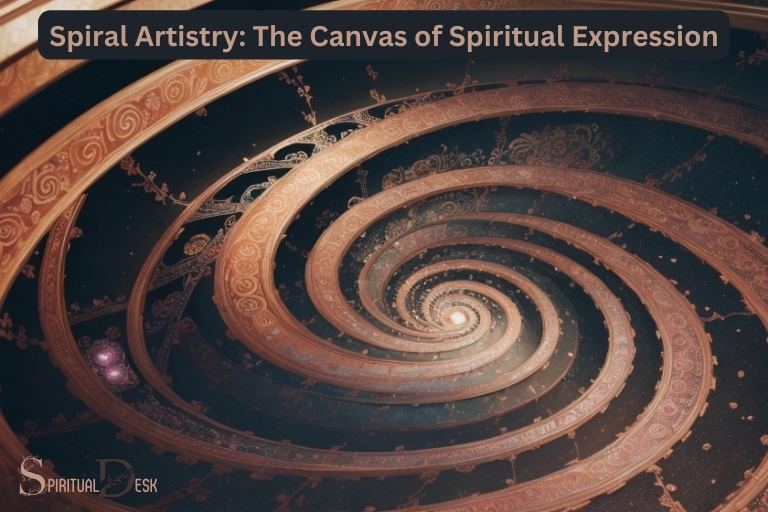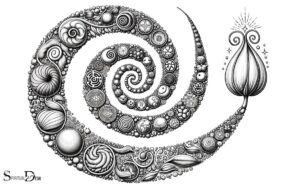Spiral Artistry: The Canvas of Spiritual Expression
Spiral artistry, also known as sacred geometry, is a form of artistic expression which symbolizes spiritual growth and evolution.
It uses the spiral shape, seen in nature and many spiritual symbols, to represent the journey of life and consciousness.
Quick Overview
In essence, spiral artistry goes beyond being just an artistic practice. It provides a canvas for individuals to express their spiritual journeys creatively.
The core principle lies in acknowledging that life is not linear but rather cyclical – akin to a spiral where one evolves through experiences constantly.
This form of art serves as a mirror reflecting profound truths about life and spirituality; thus making it deeply personal yet universally relatable at the same time.
Whether used in meditation practices or worn as symbolic jewelry pieces, spiral art reminds us of our constant evolution towards higher consciousness.

The Modern Expression Of Spirals In Art Therapy
In recent years, spirals have emerged as a powerful symbol in art therapy, representing personal transformation, growth, and spiritual expression.
Integrating spiral elements in contemporary art therapy practices offers a unique and effective way to access one’s inner self and facilitate personal healing.
Through various expressive techniques, spiral art has shown tremendous potential in trauma recovery, self-expression, and promoting self-awareness.
Integrating Spiral Elements In Contemporary Art Therapy Practices
Mindfully incorporating spiral elements in contemporary art therapy practices holds immense therapeutic value.
By intentionally utilizing spirals in art therapy sessions, therapists create a safe space for individuals to explore their emotions and experiences while tapping into their creativity.
Integrating spirals can involve using spiral patterns, shapes, or incorporating spiral motifs in the artwork created during therapy sessions.
Therapists adopt various techniques to integrate spirals, such as encouraging clients to draw spirals or guiding them to incorporate spiral movements into their artwork.
The integration of spirals in art therapy practices allows individuals to express their inner journey and helps them gain a deeper understanding of themselves.
The Healing Potential Of Spiral Art In Trauma Recovery And Self-expression
Spiral art holds significant healing potential, especially in trauma recovery and self-expression. Traumatic experiences often leave individuals feeling disconnected and struggling to put their experiences into words.
Spiral art provides a non-verbal and expressive medium for survivors to process and make sense of their emotions.
The repetitive and continuous nature of spirals can help individuals release pent-up emotions, allowing for catharsis and emotional healing.
Through the creation of spiral art, trauma survivors can externalize their inner experiences and gain a sense of control over their healing process.
Spiral art provides a transformative outlet for self-expression, enabling individuals to share their stories and experiences in a non-threatening manner.
Promoting Self-awareness, Emotional Release, And Personal Growth Through Expressive Spiral Techniques
Expressive spiral techniques in art therapy open doors to increased self-awareness, emotional release, and personal growth. By engaging in spiral art activities, individuals can delve deep into their subconscious and bring forth their innermost thoughts and emotions.
The act of creating spiral art allows individuals to connect with their intuition and access buried emotions that may have been overlooked or suppressed.
Spiral art techniques, such as spiral journaling or drawing, promote self-reflection and introspection. Through the exploration of spiral patterns, individuals gain insights into their thought patterns, behavioral tendencies, and emotional states.
This self-awareness lays the foundation for personal growth and fosters a deeper understanding of oneself.
Moreover, spiral art offers a safe space for emotional release. The rhythmic and repetitive movement of creating spirals can serve as a meditative process, aiding individuals in releasing stress, anxiety, or suppressed emotions.
The act of engaging with expressive spiral techniques allows individuals to find solace, clarity, and emotional balance.
Spirals In Sacred Architecture: Energetic Flow And Harmony
Throughout history, spiral motifs have played a significant role in sacred architecture around the world. These architectural elements go beyond mere aesthetics; they carry profound spiritual symbolism and serve a higher purpose.
Incorporating spirals into the design of sacred structures creates a sense of energetic flow and harmony, enhancing the spiritual experience within these spaces.
Incorporating Spiral Motifs In Sacred Structures Around The World
From ancient temples to modern spiritual retreat centers, spirals can be found in the architectural designs of sacred structures worldwide.
Let’s take a look at some examples of how different cultures have incorporated spiral motifs into their sacred spaces:
| Sacred Structure | Location | Spiral Design Element |
|---|---|---|
| The Great Pyramids of Egypt | Egypt | The spiral shape of the pyramids represents the journey of the soul ascending to the heavens. |
| Sagrada Familia | Barcelona, Spain | The towering spires of Antoni Gaudí’s masterpiece feature spiral motifs, symbolizing spiritual growth. |
| Borobudur | Java, Indonesia | The intricate bas-reliefs on this Buddhist temple depict mandalas with spiral patterns, representing the path to enlightenment. |
These examples demonstrate the universal appeal and spiritual significance of incorporating spiral motifs into sacred architecture. Each design element engages the observer on a deeper level, fostering a profound connection to the divine.
Unveiling The Spiritual Symbolism Behind Spiral Architecture
To truly appreciate the power of spiral architecture, it is essential to understand the spiritual symbolism embedded within these structures. Spirals have been associated with various spiritual concepts and beliefs, such as:
- Infinity and Wholeness: The continuous loop of the spiral symbolizes the infinite journey of the soul and the interconnectedness of all existence.
- Evolution and Growth: Spirals represent the unfolding and expansion of consciousness, encouraging personal and spiritual growth.
- Balance and Harmony: The spiral’s symmetrical nature and rhythmic movement evoke a sense of balance and harmony within oneself and the surrounding environment.
- Energy Flow: Spirals are believed to facilitate the movement of energy, enabling a harmonious flow between the physical and spiritual realms.
How Spiral Forms Influence Energy Circulation And Spiritual Connection
The inherent shape of spirals lends itself to enhancing energy circulation and spiritual connection within sacred structures. The design principles behind spiral architecture contribute to these effects in the following ways:
- Guided Movement: Spiral structures create a natural flow and guide individuals through a predetermined path, leading them on an intentional spiritual journey.
- Symmetry and Proportion: The balance and proportion of spiral designs promote a sense of harmony, allowing energy to circulate freely within the space.
- Energetic Resonance: The spiral’s energetic properties resonate with individuals, helping to align their own energy fields and deepen their spiritual connection.
- Cosmic Alignment: Spirals can also symbolize cosmic forces and celestial movements, aligning individuals with the larger universal energies and spiritual realms.
These profound influences of spiral forms on energy circulation and spiritual connection make sacred structures truly transformative spaces for those who seek spiritual growth and illumination.
Spiral Labyrinths: A Pathway To Self-discovery And Alignment
In the realm of spiritual expression, the spiral symbol holds transcendent power. Its infinite curves and continuous motion have been a universal motif representing growth, transformation, and the soul’s journey.
Spiral labyrinths, whether on paper or in physical form, offer a potent pathway for self-discovery and alignment.
Understanding The Ancient Labyrinth Symbolism And Its Spiritual Significance
Throughout history, labyrinths have symbolized the twists and turns of life’s journey, representing the intricate pathways we navigate in search of meaning and purpose.
The labyrinth is an archetype found in ancient cultures across the world, from the Greek myth of Theseus and the Minotaur to the stone carvings of prehistoric Celtic tribes. This sacred symbol often functions as a metaphor for the journey towards self-realization and enlightenment.
Creating And Walking Spiraling Labyrinth Patterns For Self-reflection
To delve into the meaningful spiral labyrinth experience, you can craft and walk labyrinth patterns for introspection and self-reflection. Whether on paper or as a physical labyrinth, these patterns immerse you in the spiral’s rhythm and repetition.
As you follow the winding path inward, release worries and concerns, letting the labyrinth lead you toward inner stillness and insight.
Walking the labyrinth in a meditative state can awaken dormant parts of the mind and reveal hidden truths. It is in this sacred space that individuals often experience profound moments of clarity and connection with their higher selves.
The Transformative Power Of Spiral Labyrinths In Spiritual Journeys
As seekers embark on spiritual journeys, the transformative power of spiral labyrinths becomes evident. These intricate patterns not only provide a space for contemplation but also hold the potential for profound shifts in consciousness.
Walking the labyrinth mirrors the winding journey of life, with its twists, turns, and unexpected detours.
It is through the act of traversing these spiraling pathways that individuals can gain a deeper understanding of themselves, let go of what no longer serves them, and align with their true purpose.
By threading through the labyrinth’s curves and reaching the center, individuals symbolically reach the core of their being, where profound transformations can occur.
Whether it is releasing old patterns, embracing new perspectives, or finding solace in the present moment, the spiral labyrinth offers a space for growth and self-discovery.
Spirals In Shamanic Practices: Unveiling The Mystical Realms
Shamanic cultures throughout history have recognized the power of symbols and patterns to unlock the hidden mysteries of the universe. One such symbol that holds profound significance in shamanic practices is the spiral.
Representing both the cyclical nature of life and an entryway into alternate dimensions, spirals have served as portals to the mystical realms for shamans and spiritual seekers alike.
Spirals As Portals To Alternate Dimensions In Shamanic Cultures
Across indigenous cultures, spirals are revered as gateways to higher dimensions. Their hypnotic nature embodies the flow of energy and interconnectedness in all things.
By gazing upon or creating spiral patterns, individuals align themselves with cosmic forces, transcending ordinary reality.
In shamanic journeys, spirals serve as metaphorical doorways, enabling travelers to explore altered states of consciousness and the depths of spiritual realms. This powerful tool aids shamans in connecting with spirits, seeking guidance, and uncovering hidden wisdom.
Utilizing Spiral Art For Spiritual Journeying And Soul Retrieval
The intricate design and symmetrical nature of spirals can induce a trance-like state, facilitating deep introspection and connection with the soul.
Within the sacred space created through spiral art, shamanic practitioners embark on transformative inner journeys to retrieve lost parts of the soul. This ancient practice seeks to heal trauma, restore wholeness, and regain personal power.
Through the harmonious flow of the spiral, individuals can gain access to forgotten memories, release emotional burdens, and reclaim fragments of the self that were once lost.
Shamanic Rituals And Ceremonies Involving Spiral Symbols And Patterns
Spirals hold a vital role in shamanic rituals and ceremonies, signifying the cyclical nature of life, death, and rebirth. Shamans incorporate spirals by drawing them on sacred objects, incorporating them into movements, or weaving them into garments.
This practice channels spiritual energy, connecting with divine forces and facilitating communication with spirits and ancestors.
How Can Embracing Spirals Help in the Process of Spiritual Expression?
Embracing spirals for healing can truly amplify spiritual expression. Spirals, with their continuous and evolving nature, symbolize growth and transformation. By embracing this powerful symbolism, individuals can delve into their inner selves, unraveling hidden emotions, and fostering a profound spiritual connection. Embracing spirals allows us to navigate through our spiritual journey, bringing forth healing, self-discovery, and a deeper understanding of our true essence.
The Art Of Spiral Mandalas: Balancing The Mind, Body, And Soul
Creating spiral mandalas is not only a beautiful and captivating artistic practice but also a powerful tool for spiritual expression. The combination of intricate spiral patterns and the meditative process of designing and coloring them can have profound effects on our well-being.
Exploring The Therapeutic Benefits Of Creating Spiral Mandalas
The continuous motion required to draw and color these intricate patterns promotes a sense of relaxation and can help reduce stress and anxiety.
Engaging in this creative process allows individuals to explore their emotions, promote self-reflection, and tap into their subconscious mind.
Additionally, spiral mandalas can serve as a tool for emotional healing and inner transformation. By channeling one’s emotions and intentions into the design, individuals can gain a deeper understanding of themselves and work through any emotional blockages.
Techniques For Designing And Coloring Meditative Spiral Patterns
There are various techniques that can be employed when designing and coloring meditative spiral patterns. These techniques allow individuals to customize their mandalas according to their artistic preferences and personal intentions.
One popular technique is to start with a central point and gradually extend the spirals outward. This method symbolizes personal growth and expansion. Another technique involves using different colors or shades to represent various emotions or energies. Choosing colors based on personal associations or utilizing color therapy principles can further enhance the therapeutic benefits of spiral mandala creation.
For those interested in precision and symmetry, using compasses, rulers, or stencils can help create intricate and visually appealing spiral patterns. On the other hand, embracing imperfections and allowing the spiral to evolve spontaneously can be a liberating and intuitive process, enabling individuals to tap into their creative flow.
Enhancing Mindfulness And Concentration Through Spiral Mandala Creation
The process of creating spiral mandalas requires focused attention and concentration, making it an excellent activity for enhancing mindfulness. Drawing and coloring spirals helps focus the mind and brings about a sense of calm and presence.
Engaging in spiral mandala creation can also improve concentration and attention span. As individuals intricately design and color the patterns, their ability to stay focused on the task at hand strengthens.
This enhanced concentration can then be transferred to other areas of life, helping individuals stay present and attentive in their daily activities.
Whether you are seeking a creative outlet, emotional healing, or a means to enhance mindfulness, the art of spiral mandalas offers a myriad of benefits for the mind, body, and soul.
With its therapeutic nature and the endless possibilities for personal expression, engaging in spiral mandala creation can be a fulfilling and transformative practice.
Conclusion
Spiral art serves as a powerful form of spiritual expression, resonating with individuals across cultures and belief systems.
Its intricate designs and rhythmic patterns invite a deep contemplation of life’s mysteries, helping to cultivate a sense of inner peace, mindfulness, and connection to something greater than ourselves.






